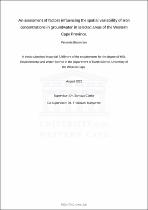| dc.description.abstract | Groundwater in South Africa, and more specifically the Western Cape Province (WCP), has become of major interest in recent years due to the unpredictable climatic conditions and the uncertainty of surface water to continuously meet the current and future water demands. With the exploration of groundwater (through the drilling of boreholes) to meet the current water demand and to ensure water security there comes the related problem of iron (Fe) and Manganese (Mn) oxidation and precipitation. The precipitation of Fe and Mn in boreholes reduce the yield and quality of the water, resulting in borehole clogging. This study took place in the WCP and the sites sampled at were hospitals as part of the business continuity project that was initiated during the drought in that took place in Cape Town in 2017. There are 4 objectives for this study which are to assess spatial variations in Fe and Mn concentrations, to establish site-specific processes controlling the concentration of Fe and Mn in groundwater, to model the likelihood of precipitation of Fe and Mn based on detected solution composition and to assess the best practice method/techniques for sampling Fe and Mn. This research project made use of quantitative and qualitative research methods. The first two objectives was addressed by using historical data which included groundwater chemistry data, pumping test data and geological data of the WCP. In addition to the historical data being used sampling was done at selected sites to understand the current groundwater chemistry, while interviews were conducted with site maintenance personnel to further understand the management of the boreholes. The third objective made use of the PHREEQC software to determine the saturation indices of samples collected and modelling of the effect of change in Fe, Mn, redox potential, pH and temperature has on the precipitation of Fe and Mn minerals. The last objective was achieved through the sampling conducted which provided the opportunity to test the best practice sampling methods of Fe and Mn in groundwater. | en_US |

